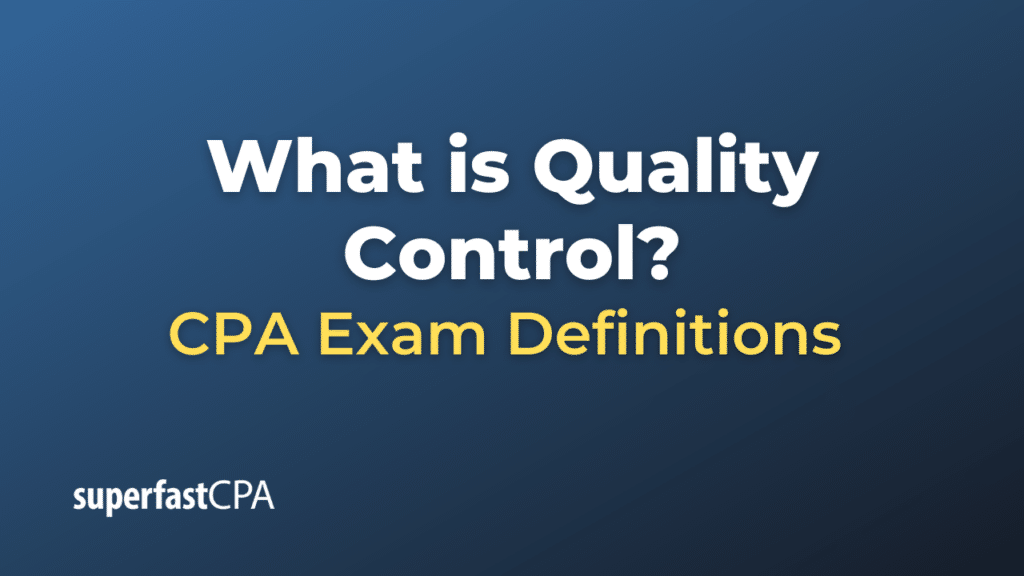Quality Control
Quality Control (QC) refers to the techniques and activities used to ensure that a product or service meets specified requirements and standards. It is a reactive approach, focusing on identifying and rectifying defects in finished products before they reach the consumer. QC typically involves testing units and determining if they are within the specifications for the desired final product.
Key characteristics of Quality Control include:
- Inspection and Testing: This is the cornerstone of QC. Products, components, or services are inspected or tested to ensure they meet the defined specifications.
- Sampling: Given the impracticality of inspecting every single item in large batches, QC often involves sampling a subset of products and testing them for defects. Statistical methods can then estimate the quality of the entire batch.
- Use of Standards: QC measures the product or service against defined standards or benchmarks to determine its quality.
- Documentation: Detailed records of QC tests, inspections, and results are maintained. This documentation can be used for future reference, compliance checks, and continuous improvement initiatives.
- Corrective Actions: If defects or deviations from the standard are identified, corrective actions are taken. This might involve repairing the product, rejecting it, or even reworking the entire batch.
- Tools and Techniques: Various tools like control charts, checklists, and statistical tests are employed in QC to monitor quality levels, identify trends, and detect potential problems.
It’s worth noting the difference between Quality Assurance (QA) and Quality Control (QC):
- Quality Assurance (QA): QA is a proactive and process-oriented approach. It focuses on preventing defects by ensuring that the processes used to create the product are adequate and continuously improved.
- Quality Control (QC): QC is more product-oriented and reactive. It involves examining the end product or service to ensure it meets the set quality standards.
In many industries, particularly the software development industry, the terms QA and QC might be used somewhat interchangeably, though they have distinct roles in the broader quality management system.
QC plays a crucial role in industries where defects can have significant consequences, such as pharmaceuticals, automobiles, and aerospace. Ensuring products meet or exceed quality standards can help companies avoid costly recalls, legal issues, and damage to their brand reputation.
Example of Quality Control
Let’s use the example of a company that manufactures children’s toys to illustrate Quality Control (QC) in action:
StarKidz Toys
StarKidz Toys produces a popular line of plastic toy cars for children. Given the target demographic, ensuring that these toys are free from defects and safe for children is of paramount importance.
Quality Control Measures:
- Material Inspection: Before production begins, the raw plastic material is inspected for any impurities. They ensure it’s free from harmful chemicals that could be a danger to children.
- Production Line Sampling: Every hour, a set number of toy cars are taken off the assembly line and checked for defects like sharp edges, broken parts, or any other imperfections.
- Functional Tests: These sampled toys are also tested for functionality. For instance, if the toy car is supposed to have doors that open and close, QC staff will test this feature repeatedly to ensure its durability and proper function.
- Weight and Dimension Checks: Each toy car has a specified weight and dimension. Random samples are weighed and measured to ensure they’re within the allowed tolerances.
- Durability Testing: Some of the toy cars are subjected to “stress tests,” where they’re dropped from heights or pressed under weights. This ensures they won’t easily break when used by children.
- Batch Documentation: Every batch of toy cars has associated documentation that records the QC checks performed, the number of defects found, and any corrective actions taken.
- Feedback from Customers: StarKidz has a system in place to gather feedback from customers. If there are complaints about the quality of a particular batch of toys, QC can refer back to the batch’s documentation to identify potential issues.
Potential Scenario:
During one of the hourly checks, a QC inspector finds that several toy cars have wheels that aren’t fixed securely. This presents a potential choking hazard for children. The inspector immediately flags this batch, halting its packaging and shipment.
The production team is informed, and they identify a malfunction in the machine that attaches the wheels. The machine is repaired, and the defective toy cars are fixed before they’re allowed to continue to the packaging stage.
This quick response ensures that potentially harmful toys don’t reach the market, safeguarding children and upholding the company’s reputation for quality.
This example highlights the pivotal role QC plays in product manufacturing, ensuring that consumers receive safe, high-quality products.













